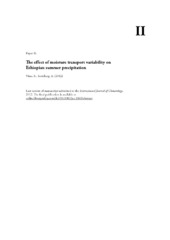The effect of moisture transport variability on Ethiopian summer precipitation
Peer reviewed, Journal article
Accepted version
Permanent lenke
https://hdl.handle.net/1956/6261Utgivelsesdato
2013-12Metadata
Vis full innførselSamlinger
- Geophysical Institute [1198]
Originalversjon
https://doi.org/10.1002/joc.3566Sammendrag
The main rainy season in Ethiopia occurs during the northern hemisphere summer, when air masses carrying moisture from the Indian Ocean, the Gulf of Guinea, the African continent, the Red Sea, and the Mediterranean Sea, converge above the Ethiopian mountain plateau. In this study, the variability in different branches of this transport has been studied using the Lagrangian trajectory model FLEXPART and ERA-Interim reanalysis data for July–August 1998–2008. The largest relative fluctuations occur in the normally limited transport from the Gulf of Guinea, whereas smaller relative changes in the larger branches from the Indian Ocean and the regions to the north, often have greater effects. Wet/dry summer months in the northern Ethiopian highlands were associated with increased/reduced transport of moisture from the south, with consequent changes in the release of moisture in the region. In dry months, the moisture transport from the south was reduced to 85 % of its mean, and in wet months increased to 107 %. The increased transport in wet months could be attributed to low-level westerly anomalies above Central Africa – increasing moisture transport from the Gulf of Guinea and in most cases also from the Indian Ocean – and with enhanced southerlies along the coast of East Africa, increasing the transport from the Indian Ocean. The amount of moisture transported into the highlands from the north could not be consistently associated with wet and dry months, but in most cases the release of moisture in air coming from the north contributed to the resulting precipitation anomaly. The release of moisture in the northern branch was reduced to 94 % of its mean in dry months, and increased to 111 % in wet months. This may be an effect of altered convergence associated with changes in the transport from the south.
